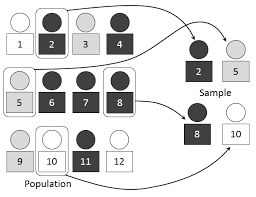Statistical Sampling Methods
 Statistical sampling is a method used in statistical analysis to select a representative subset, or sample, of a larger population. The goal of statistical sampling is to make inferences about the population based on data collected from the sample.
Statistical sampling is a method used in statistical analysis to select a representative subset, or sample, of a larger population. The goal of statistical sampling is to make inferences about the population based on data collected from the sample.
There are several different types of sampling methods, including:
- Simple random sampling: In this method, each member of the population has an equal chance of being selected for the sample.
- Stratified sampling: This method involves dividing the population into subgroups, or strata, and then selecting a sample from each stratum in proportion to the size of the stratum.
- Cluster sampling: This method involves dividing the population into clusters, or groups, and then randomly selecting a few clusters for the sample.
- Systematic sampling: This method involves selecting members of the population at regular intervals, such as every 10th person or every 20th person.
- Convenience sampling: This method involves selecting individuals who are readily available or convenient to the researcher, such as students in a classroom or patients in a hospital.
Each sampling method has its own advantages and disadvantages, and the choice of method will depend on the research question, the characteristics of the population, and other factors. The goal of statistical sampling is to ensure that the sample is representative of the population and that the results obtained from the sample can be generalized to the larger population with a certain level of confidence. Learn more about Statistical Sampling in one of our many statistical methods training courses taught by expert university instructors.
Statistical Methods Training Courses
How is Statistical Sampling Used in Statistical Methodology?
Statistical sampling is a critical component of statistical methodology, which is the set of principles and techniques used in the analysis and interpretation of data. Statistical sampling is used in statistical methodology to select a representative subset, or sample, of a larger population and to make inferences about the population based on data collected from the sample.
The use of statistical sampling in statistical methodology has several advantages, including:
- Cost-effectiveness: Sampling a smaller subset of the population can be much less expensive and time-consuming than collecting data from the entire population.
- Precision: When a sample is selected correctly, statistical sampling can provide estimates that are as accurate as those obtained from the entire population.
- Generalizability: Statistical sampling allows researchers to make inferences about the larger population based on data collected from a representative sample.
Statistical sampling is used in statistical methodology to estimate population parameters such as means, variances, and proportions, and to test hypotheses about the population using inferential statistics. The choice of sampling method will depend on the research question, the characteristics of the population, and other factors, and a well-designed sampling plan is essential to ensure that the results obtained from the sample are representative of the larger population.
In summary, statistical sampling is a fundamental component of statistical methodology and is used to select a representative sample of a larger population and to make inferences about the population based on data collected from the sample. The use of statistical sampling allows researchers to obtain accurate and cost-effective estimates of population parameters and to test hypotheses about the population using inferential statistics.
